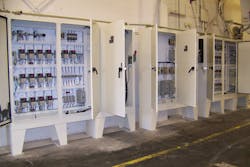New Automation Strategy Drives Control System Migration
System integration and engineering firm, Optimation (Rush, N.Y.), was presented with the challenge of replacing a food production company’s legacy ABB MOD300 distributed control system (DCS) while ensuring that production would not be interrupted for more than two weeks. The food producer wanted a new automation system installed that could provide for plant-wide control and support the use of multiple operator screens for coordination of work with the production team.
To deliver on these requirements, Rockwell Automation’s ControlLogix PlantPAx process automation system was selected.
While the physical system migration process was taking place, Optimation’s control panel shop built panels in a staging area for operators to be trained on using a simulated model of their production environment. Concurrently, Optimation’s electrical installation team installed new conduit and pre-bundled electrical cables in advance of the shutdown window. Optimation also upgraded the field wiring in the silo area to Class 2 Div. 2 standards.
Once the installation team was comfortable with system operation in simulation mode, a round-the-clock dismantle-and-install effort involving more 35 electricians commenced.
System Architecture
When laying out a replacement for a DCS, it’s important to accommodate the advanced functionality normally associated with these installations. Login authorization, alarm management, event logging, real- time trending, historical logs, cascaded PID control, batch management, integrated user consoles, I/O status screens and preconfigured faceplates were all used at this location for over 30 years.
Optimation designed the new system with a Batch Server, Historian Server and a View Server (Operator Visualization) alongside the CompactLogix Controller and multiple Remote I/O panels. This new architecture preserved the advanced functionality of the legacy system while adding the benefit of reduced wiring, as remote panels were located closer to the production equipment.
Risk Mitigation
Minimum shutdown time was the most critical aspect of this project. Optimation performed a review to determine the greatest areas of risk to the schedule and identified that these risks were: migration of operational logic, batch functionality, health of existing equipment and project management. As an additional measure, a Rockwell technical specialist worked with Optimation during this process and provided design review input.
Optimation worked closely with the on-site engineers to ensure that the functionality of the existing loops, I/O lists and recipe system were documented in a functional specification and signal list. These documents were then used to carry out the design of the new software. To ensure that the completed system met the operator’s expectations, a simulation of the production system was built into the control system. The plant engineers and manager tested the system, and then operators were each scheduled to run simulated production prior to panels being installed on site.
Batch Control and Manual Mode
Prior to working with Optimation, batches at the production facility were scheduled using an S88-style interface that included unit selection and phases, as well as the ability to manually control a batch by pausing and resuming it. In addition, a supervisor could operate outside of the batch system using a manual control panel to clear problems or test new products. With the new system, however, setting up such a manual control panel would be troublesome from a maintenance perspective.
Rockwell’s Batch Server provides S88 compatible functionality to manage batches. Also, sub-recipes for similar products help simplify recipe creation, avoiding duplication of data. Despite these capabilities, the producer remained concerned that lack of a manual panel would slow testing. To address this concern, Optimation devised a manual mode screen that could run phases in the controllers without need for the Batch Server to be functioning. This approach proved to be a better solution than the manual panel, since the phase logic performs a series of small operations that can still be constrained by interlocks and permissives for added safety.
An additional new capability of the system design was to provide for material tracking and campaign launches. Optimation used SQL databases and advanced application programming interfaces to help simplify the process of keeping track of inventory levels of materials, and to allow large runs to be scheduled as a campaign of smaller recipes. These capabilities extended the functionality of the system and helped reduce the time involvement for the operators.
Project Management & Results
A critical aspect of this migration project involved Optimation’s coordination of engineers and skilled trades working together to meet and verify the phases and gates set up by the project manager. A “go/no-go” milestone was established with reliable information from the automation system engineers, electrical installers and the production staff.
Production operations were down for only 12 days during the switchover. In addition, the production rate increased by 5 percent with the new control system in place. This increase was achieved due to faster system response in changing over jobs and running campaigns.

